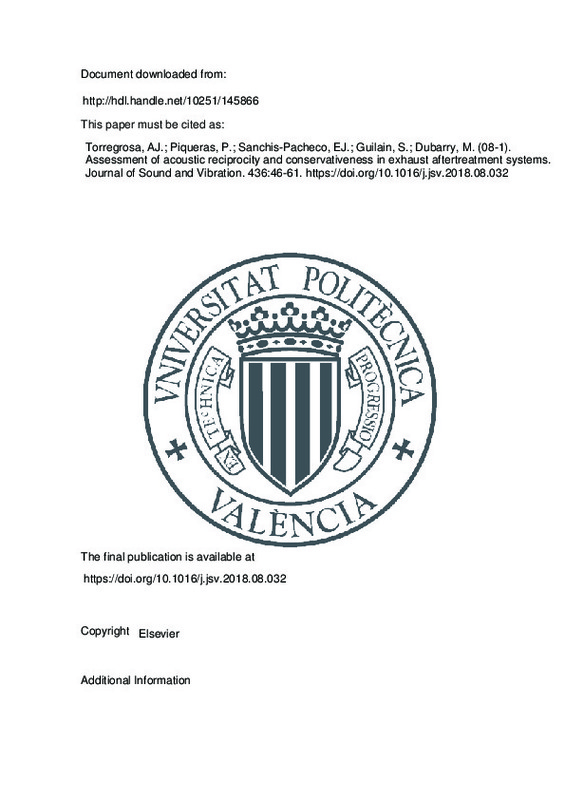JavaScript is disabled for your browser. Some features of this site may not work without it.
Buscar en RiuNet
Listar
Mi cuenta
Estadísticas
Ayuda RiuNet
Admin. UPV
Assessment of acoustic reciprocity and conservativeness in exhaust aftertreatment systems
Mostrar el registro sencillo del ítem
Ficheros en el ítem
| dc.contributor.author | Torregrosa, A. J.
|
es_ES |
| dc.contributor.author | Piqueras, P.
|
es_ES |
| dc.contributor.author | Sanchis-Pacheco, Enrique José
|
es_ES |
| dc.contributor.author | Guilain, S.
|
es_ES |
| dc.contributor.author | Dubarry, M.
|
es_ES |
| dc.date.accessioned | 2020-06-10T03:32:36Z | |
| dc.date.available | 2020-06-10T03:32:36Z | |
| dc.date.issued | 2018-12-08 | es_ES |
| dc.identifier.issn | 0022-460X | es_ES |
| dc.identifier.uri | http://hdl.handle.net/10251/145866 | |
| dc.description.abstract | [EN] Tightening emission standards limiting gas and aerosol emissions from internal combustion engines have led to the extensive use of exhaust aftertreatment systems (EATS) with different chemical functions as a solution to meet standards requirements. Incidentally, the placement of aftertreatment monolithic devices into the exhaust line also plays a key role on the exhaust noise emission. Their presence disturbs the pattern of the pressure waves and sets the boundary conditions for the silencer design. The impact of the EATS on wave transmission can be analyzed by means of the transmission or scattering matrix. The present work discusses the implications of acoustic reciprocity and conservativeness on the definition of the scattering matrix elements. The fulfillment of these properties in real operating conditions was evaluated against a set of experimental data obtained for several exhaust aftertreatment monolithic bricks in an impulse test rig. The influence of different excitation amplitudes and superimposed mean flows was also considered. Once it was shown that the devices are reciprocal, the need to account for dissipation phenomena was evidenced. Finally, the application of reciprocity and conservativeness together with dissipation provided simple expressions allowing to predict the response of the EATS in the inverse direction, i.e. from outlet to inlet, from the transmission and reflection properties obtained in the direct direction. Thus, the proposed procedure becomes useful to reduce both the required number of tests and the gas dynamics modelling work in methodologies driven to assess the acoustic response of EATS based on the use of experimental and computational tools. (C) 2018 Elsevier Ltd. All rights reserved. | es_ES |
| dc.description.sponsorship | This research has been partially supported by FEDER and the Government of Spain through project TRA2016-79185-R. Additionally, the Ph.D. student Enrique José Sanchis has been funded by a grant from Universitat Politècnica de València with reference FPI-2016-S2-1355. | es_ES |
| dc.language | Inglés | es_ES |
| dc.publisher | Elsevier | es_ES |
| dc.relation.ispartof | Journal of Sound and Vibration | es_ES |
| dc.rights | Reserva de todos los derechos | es_ES |
| dc.subject | Internal combustion engine | es_ES |
| dc.subject | Exhaust aftertreatment system | es_ES |
| dc.subject | Acoustics | es_ES |
| dc.subject | Scattering matrix | es_ES |
| dc.subject | Reciprocity | es_ES |
| dc.subject | Dissipation | es_ES |
| dc.subject.classification | MAQUINAS Y MOTORES TERMICOS | es_ES |
| dc.title | Assessment of acoustic reciprocity and conservativeness in exhaust aftertreatment systems | es_ES |
| dc.type | Artículo | es_ES |
| dc.identifier.doi | 10.1016/j.jsv.2018.08.032 | es_ES |
| dc.relation.projectID | info:eu-repo/grantAgreement/UPV//FPI-2016-S2-1355/ | es_ES |
| dc.relation.projectID | info:eu-repo/grantAgreement/MINECO//TRA2016-79185-R/ES/DESARROLLO DE HERRAMIENTAS EXPERIMENTALES Y COMPUTACIONALES PARA LA CARACTERIZACION DE SISTEMAS DE POST-TRATAMIENTO DE GASES DE ESCAPE EN MOTORES DE ENCENDIDO POR COMPRESION/ | es_ES |
| dc.rights.accessRights | Abierto | es_ES |
| dc.contributor.affiliation | Universitat Politècnica de València. Departamento de Máquinas y Motores Térmicos - Departament de Màquines i Motors Tèrmics | es_ES |
| dc.description.bibliographicCitation | Torregrosa, AJ.; Piqueras, P.; Sanchis-Pacheco, EJ.; Guilain, S.; Dubarry, M. (2018). Assessment of acoustic reciprocity and conservativeness in exhaust aftertreatment systems. Journal of Sound and Vibration. 436:46-61. https://doi.org/10.1016/j.jsv.2018.08.032 | es_ES |
| dc.description.accrualMethod | S | es_ES |
| dc.relation.publisherversion | https://doi.org/10.1016/j.jsv.2018.08.032 | es_ES |
| dc.description.upvformatpinicio | 46 | es_ES |
| dc.description.upvformatpfin | 61 | es_ES |
| dc.type.version | info:eu-repo/semantics/publishedVersion | es_ES |
| dc.description.volume | 436 | es_ES |
| dc.relation.pasarela | S\370842 | es_ES |
| dc.contributor.funder | European Regional Development Fund | es_ES |
| dc.contributor.funder | Universitat Politècnica de València | es_ES |
| dc.contributor.funder | Ministerio de Economía y Competitividad | es_ES |







![[Cerrado]](/themes/UPV/images/candado.png)

